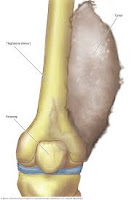Skin cancer is one of the commonest forms of this malignant disease. It is commonly caused by exposure of the skin to the sun. Before we talk about the 3 leading causes of skin cancer, let's take a look at the different types of skin cells and their basic functions.
 |
| http://cancers-list.blogspot.com/ |
The top layer of the skin is called epidermis, and it has 3 major types of cells squamous, basal and melanocytes. Squamous cells line the inside of the skin, just below the visible outer layer.
Below the layer of squamous cells are basal cells, which act as generators of new cells. The final layer of the epidermis consists of melanocytes. These cells produce melanin, a coloring pigment that determines your skin tone. This pigment also plays a vital role in protecting the skin from the harmful UV rays.
1. UV Radiations
A major cause of skin cancer is the ultra violet radiations from the sun. It is caused either due to long-term or short-term exposure to these harmful rays. The 2 common types of UV rays that affect the skin are UVA and UVB. Both the types of sun rays are known to be cancer causing. How do these rays work on damaging the skin cells? They go straight for the jugular - here, the DNA of the skin cells. Once the cell's code is damaged, the cells tend to multiply quickly, leading to cancerous growth. It is not just the sun's UV rays are harmful, even radiations from tanning bed and solarium have been found to be carcinogenic.
2. Chemicals
Many chemicals have also been found to cause non-melanoma cancer. Some of the harmful chemicals are arsenic, shale oil, petroleum products, soot, pitch, nicotine, coal-tar and creosote. People working in chemical factories or leather tanneries may be exposed to one or many of these carcinogenic chemicals. Their work conditions make their skin more vulnerable to the UV rays and to skin cancer.
3. Skin Conditions
Those suffering from skin conditions are prone to this form of cancer as the skin cells are already weak and can be easily affected by the carcinogens. Psoriasis, solar keratosis, Gorlin's syndrome, Xeroderma pigmentosum and eczema could increase the risk of skin cancer. These skin conditions do not by themselves cause skin cancer, but could hasten the formation of cancerous cells as they weaken the skin cells and reduce their natural ability to repair and renew.
Skin Cancer, Skin Cancer, Skin Cancer, Skin Cancer, Skin Cancer, Skin Cancer, Skin Cancer, Skin Cancer, Skin Cancer, Skin Cancer, Skin Cancer, Skin Cancer, Skin Cancer, Skin Cancer, Skin Cancer, Skin Cancer, Skin Cancer, Skin Cancer, Skin Cancer, Skin Cancer, Skin Cancer, Skin Cancer, Skin Cancer, Skin Cancer, Skin Cancer, Skin Cancer, Skin Cancer, Skin Cancer, Skin Cancer, Skin Cancer, Skin Cancer, Skin Cancer, Skin Cancer, Skin Cancer, Skin Cancer, Skin Cancer, Skin Cancer, Skin Cancer, Skin Cancer, Skin Cancer, Skin Cancer, Skin Cancer, Skin Cancer, Skin Cancer, Skin Cancer, Skin Cancer, Skin Cancer, Skin Cancer, Skin Cancer, Skin Cancer, Skin Cancer, Skin Cancer, Skin Cancer, Skin Cancer, Skin Cancer, Skin Cancer, Skin Cancer, Skin Cancer, Skin Cancer, Skin Cancer, Skin Cancer, Skin Cancer, Skin Cancer, Skin Cancer, Skin Cancer, Skin Cancer, Skin Cancer, Skin Cancer, Skin Cancer, Skin Cancer, Skin Cancer, Skin Cancer, Skin Cancer, Skin Cancer, Skin Cancer, Skin Cancer, Skin Cancer, Skin Cancer, Skin Cancer, Skin Cancer, Skin Cancer, Skin Cancer, Skin Cancer, Skin Cancer, Skin Cancer, Skin Cancer, Skin Cancer, Skin Cancer, Skin Cancer, Skin Cancer, Skin Cancer, Skin Cancer, Skin Cancer, Skin Cancer, Skin Cancer, Skin Cancer, Skin Cancer, Skin Cancer, Skin Cancer, Skin Cancer, Skin Cancer, Skin Cancer, Skin Cancer, Skin Cancer, Skin Cancer, Skin Cancer, Skin Cancer, Skin Cancer, Skin Cancer, Skin Cancer, Skin Cancer, Skin Cancer, Skin Cancer, Skin Cancer, Skin Cancer, Skin Cancer, Skin Cancer, Skin Cancer, Skin Cancer, Skin Cancer, Skin Cancer, Skin Cancer, Skin Cancer, Skin Cancer, Skin Cancer, Skin Cancer, Skin Cancer, Skin Cancer, Skin Cancer, Skin Cancer, Skin Cancer, Skin Cancer, Skin Cancer, Skin Cancer, Skin Cancer, Skin Cancer, Skin Cancer, Skin Cancer, Skin Cancer, Skin Cancer, Skin Cancer, Skin Cancer, Skin Cancer, Skin Cancer, Skin Cancer, Skin Cancer, Skin Cancer, Skin Cancer, Skin Cancer, Skin Cancer, Skin Cancer, Skin Cancer, Skin Cancer, Skin Cancer, Skin Cancer, Skin Cancer, Skin Cancer, Skin Cancer, Skin Cancer, Skin Cancer, Skin Cancer, Skin Cancer, Skin Cancer, Skin Cancer, Skin Cancer, Skin Cancer, Skin Cancer, Skin Cancer, Skin Cancer, Skin Cancer, Skin Cancer, Skin Cancer, Skin Cancer, Skin Cancer, Skin Cancer, Skin Cancer, Skin Cancer, Skin Cancer, Skin Cancer, Skin Cancer, Skin Cancer, Skin Cancer, Skin Cancer, Skin Cancer, Skin Cancer, Skin Cancer, Skin Cancer, Skin Cancer, Skin Cancer, Skin Cancer, Skin Cancer, Skin Cancer, Skin Cancer, Skin Cancer, Skin Cancer,
























